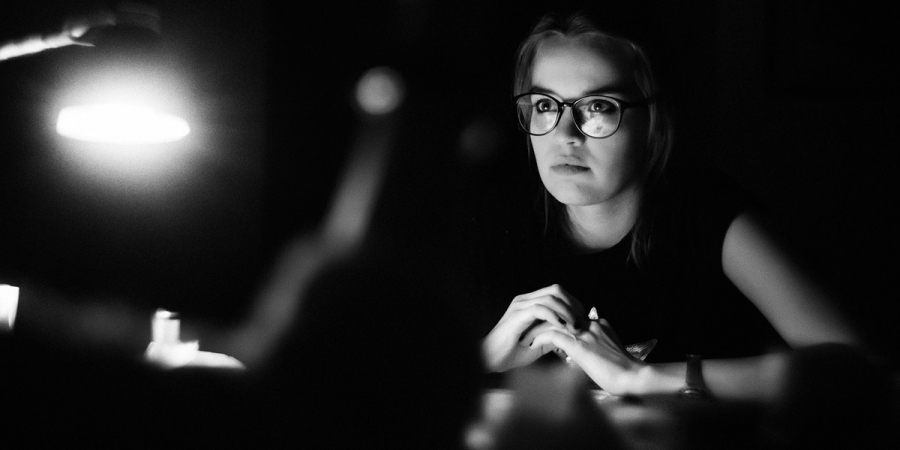Lone Vigils: Paranormal Term Explained

Photo: © StockSnap
The term "lone vigils" is one that frequently crops up in paranormal investigations, in television shows, and in videos posted on paranormal YouTube channels. It describes the practice of spending a period of time alone in a location reputed to be haunted with the goal of encountering or communicating with the spirits that are said to inhabit the space.
The idea behind going it alone is rooted in the belief that a solitary individual may be more approachable to spirits or that the quiet and concentrated focus of one person might create a more conducive environment for paranormal phenomena to manifest. Although in the world of paranormal television, lone vigils serve more as a way to show us our favourite ghost hunting stars getting scared alone in the dark.
The concept of lone vigils can seem a bit contradictory when compared with group investigations, where there's often an emphasis on building collective energy in order to elicit paranormal phenomena. This belief is based on the theory that spirits or entities can draw on this energy to manifest or communicate.
In contrast, a lone vigil embodies a calmer and "low-energy" approach. The solitude and quietness are thought to create a different kind of conducive environment for paranormal encounters, one where the investigator is more open to subtle incidents that might be overshadowed by the noise and activity of a group.
It's possible that both approaches have their place and effectiveness, depending on the specific circumstances, the location, and the type of entities believed to be present. Some spirits or paranormal phenomena might respond more to the vibrancy and energy of a group, while others might be more likely to make their presence known in a calm, quiet setting offered by a lone vigil.
The main benefit of conducting a lone vigil is that it provides a heightened sense of immersion and focus. Without the distractions of a group, the investigator can tune into the environment more acutely, paying closer attention to subtle sounds, temperature changes, and visual anomalies that might otherwise be missed. Plus, some believe that certain spirits might be more inclined to communicate with or show themselves to a single individual, who might be perceived as less threatening than a group. This one-on-one setting can lead to experiences that are more profound and direct.
Another benefit is that lone vigils can result in more robust evidence. With only one person present, there's a reduced risk of contamination from other sources, such as whispers, footsteps, movement, or equipment noise from team members. This can lead to cleaner audio recordings for electronic voice phenomena (EVP) sessions and more credible visual evidence, as there's less chance of misidentifying a team member as something paranormal.
However, you can't completely remove the possibility of contamination from other team members if they are investigating elsewhere in the building. The presence of others, even in different parts of a location, can lead to contamination of audio and visual data, misinterpretation of experiences, and increased difficulty in maintaining a controlled investigation environment.
Sounds can travel in unpredictable ways, especially in old or structurally complex locations often associated with hauntings. An investigator conducting a lone vigil might hear these sounds and believe they are interacting with a spirit, when in fact, it's just the noise created by their colleagues.
Visual contamination can also occur, particularly in environments where light can travel or reflect in unexpected ways. The use of flashlights, camera flashes, or other light sources by team members in distant parts of the building can create shadows or light anomalies that might be misinterpreted by someone conducting a lone vigil.
Hyperarousal
There are a few other downsides to this approach to ghost hunting. Most notably, the psychological impact of being alone in a dark, potentially haunted location. This sort of atmosphere can be intensely frightening and stressful, even for experienced investigators. The isolation can amplify anxieties and fears, potentially leading to a state of hyperarousal.
This state of increased psychological and physiological tension can sharpen certain senses while dulling others, leading to a skewed perception of the environment, where ordinary noises or shadows might be misinterpreted as paranormal activity. Investigators might become more suggestible and more attuned to minor sounds or changes in temperature, interpreting these normal occurrences as paranormal. This heightened sensitivity can result in the misinterpretation of events, where natural explanations are overlooked in favour of supernatural ones.
The increased tension and alertness can lead to a jumpier, more reactive state. Investigators might respond more dramatically to unexpected stimuli, such as wildlife disturbances or structural noises, falsely attributing these to ghostly interactions. This reactive state can cloud judgement, making it challenging to conduct a calm, rational investigation.
In extreme cases, this state of hyperarousal can lead to panic attacks or debilitating fear, potentially endangering the investigator's mental health and physical safety, particularly in environments with physical hazards.
Understanding the potential for hyperarousal and recognising its signs can help investigators prepare mentally and physically for a lone vigil. This preparation might include relaxation techniques, such as deep breathing or mindfulness, to manage stress levels. Keeping lone vigils short and taking regular breaks during the investigation can help manage hyperarousal by allowing time to relax, process experiences, and reduce tension.
Another downside is the lack of immediate support in case of an emergency. If an investigator gets hurt, becomes ill, or experiences a significant psychological scare, there's no one on hand to provide assistance or make decisions about ending the session for safety reasons.
There's also the issue of evidence validation. When experiences or evidence are captured during a lone vigil, the absence of witnesses can make it harder to validate or corroborate findings. Skeptics might more easily dismiss personal experiences or evidence collected in solitude, arguing that there's no way to verify the investigator's claims without bias or error.
Tips & Best Practices
The goal of a lone vigil is not just to seek out paranormal activity but to gather evidence in a controlled and credible manner. To ensure that your lone vigil is as effective and safe as possible, here are some best practice tips and things to remember.
Safety First
Always let someone know where you are and what you're doing. If you're investigating as part of a team, ensure they know your location within the building and check in regularly. Have a way to communicate with them in case of an emergency, such as a walkie-talkie or a mobile phone with good signal coverage, and make sure you have a working flashlight with you.
Prepare Mentally & Physically
Ensure you're well-rested and in a good state of mind before starting your vigil. Being in a dark, potentially eerie environment can be taxing both mentally and physically, so it's important to be prepared.
Stay Rational
Keep a level head and remember that many natural phenomena can mimic paranormal activity. Always look for logical explanations for anything unusual you encounter. It's natural to feel scared during a lone vigil, but try to control your fear. Panic can cloud your judgement and lead to mistaken interpretations of normal events as paranormal.
More Essential Parapsychology View All
Related Content
Daily Horoscopes
You May Also Like
























